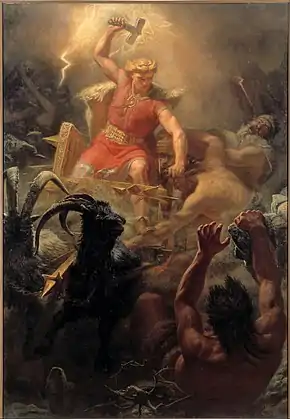Thor's Fight with the Giants
Thor's Fight with the Giants (Swedish: Tors strid med jättarna) is an 1872 painting by the Swedish artist Mårten Eskil Winge. It depicts the Norse god Thor in a battle against the jötnar. The thunder god rides his chariot pulled by the goats Tanngrisnir and Tanngnjóstr, wears his belt Megingjörð, and swings his hammer Mjölnir, which is wreathed in lightning. The painting was made using oil on canvas, has the dimensions 484 x 333 centimeters, and belongs to Nationalmuseum in Stockholm.

History
Winge was a professor at the Royal Swedish Academy of Arts, where history painting was regarded as the most important genre of art. He also belonged to the Swedish national liberal movement, in which Norse myths and legends were frequently used as motifs.[1] The painting was finished in 1872 and bought by King Charles XV, who died the same year and bequeathed it to Nationalmuseum.[2]
Reception
The painting was exhibited publicly at Nationalmuseum in 1872. It was received positively in the press and immediately drew large crowds; some people stood in line for hours to see it. The young August Strindberg wrote a positive review in which he interpreted the subject matter as a depiction of truth's struggle against falsehood.[1] The art historian Bo Grandien characterized the painting in 1987 as an example of the national liberal movement using Norse motifs to extol democracy and the fight against ignorance.[1]
In the 20th century the painting became popular among nationalists.[2] In 1992, by which time it was no longer exhibited publicly, the art historian Per Hedström wrote in Dagens Nyheter that it reminded him of the covers of hard rock albums and had become popular among skinheads: the dark jötnar against whom the blond Thor raises his hammer could be interpreted as immigrants, and the swastika on Thor's belt might add further to the appeal.[1][2] Hedström wrote: "So can the meaning of an image shift from being a symbol of liberty and enlightenment to becoming a symbol of xenophobia and right-wing extremism. From being an image for an elite to becoming a cult image within a subculture."[1]
See also
- Swastika (Germanic Iron Age): the symbol appears throughout the archaeological record of the ancient Germanic peoples.
References
- Hedström, Per (1992-09-27). "Galleriet". Dagens Nyheter (in Swedish). Archived from the original on 2016-01-27.
Så kan en bilds betydelse förskjutas från att vara en symbol för frihet och upplysning till att bli en symbol för främlingsfientlighet och högerextremism. Från att vara en bild för en elit till att bli en kultbild inom en subkultur.
- "Tor's Fight with the Giants". Nationalmuseum. Retrieved 2021-01-12.